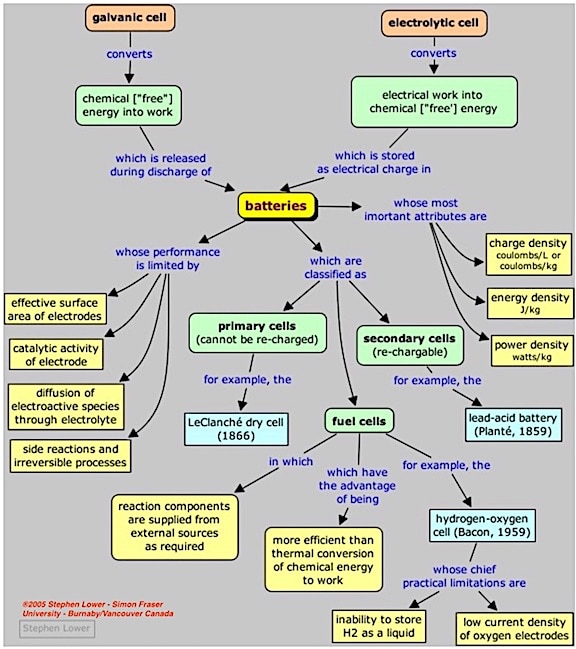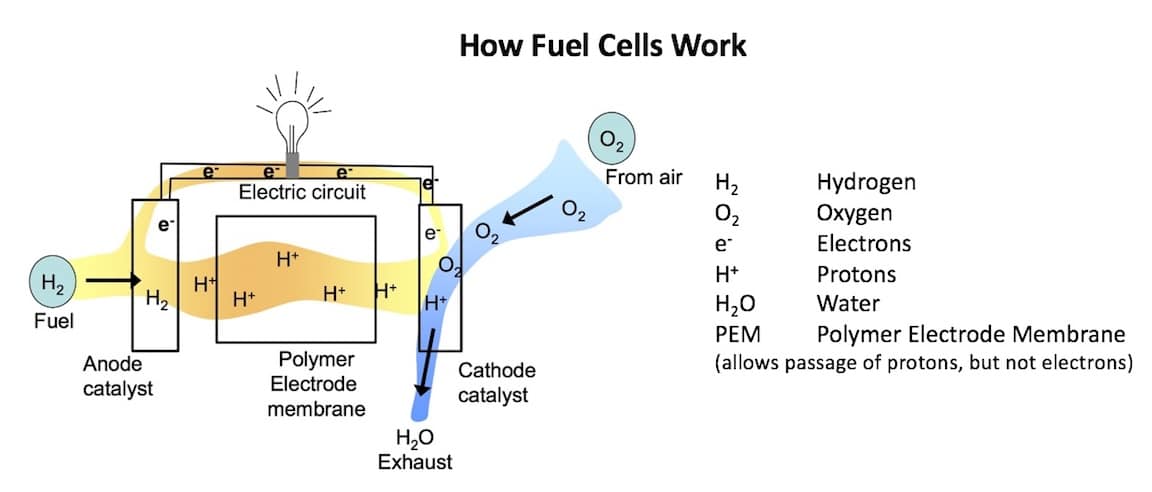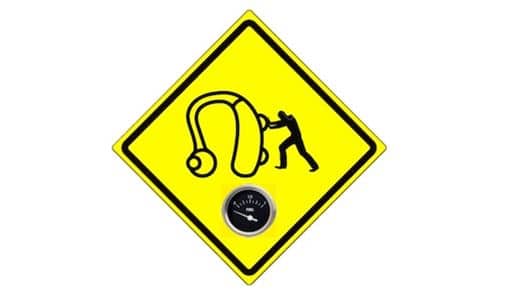In a previous article, in discussing hearing aid power supplies, it was mentioned that depending on its design, a power supply (battery) may obtain its energy from different types of energy sources, including electrical energy transmission systems, energy storage devices such as batteries, and fuel cells.
Hearing aids have used storage batteries for many years, but what about hearing aid fuel cells?
Obviously, having a hearing aid connected with an electrical cord to a wall outlet is/has not been practical because the hearing aid is a portable device. Therefore, hearing aids have traditionally used batteries (energy storage devices) as their source of power. Substantial improvements have occurred over time, with one of the most significant being able to provide more storage in a single cell, rather than in a battery (an accumulation of cells connected to each other). Most hearing aids currently use zinc-air cells as their power supply.
Fuel Cells for Hearing Aids
However, as hearing aids have become more sophisticated, including Bluetooth options and utilizing streaming, circuit current drains have gone up substantially, and the power supply has become one of the greatest obstacles hindering expanded use of new wireless transmission. It is with interest, in addition to more traditional methods to the management of the power supply, that at least two hearing aid companies (Widex, along with the Danish Technical Institute)1,2, and Oticon3 are investigating the use of fuel cells as a hearing aid power source.
The initial announcement relative to the Widex participation (1999) stated:
“Place the hearing aid in a docking station. Wait 10 seconds while it fills 200 µl methanol and the hearing aid will have enough energy for 72 hours of use. Simultaneously, the inconvenient shift of zinc-batteries will become history and the environmental impact will be reduced to a minimum1.”
The cell to be used by both companies proposes methanol as the fuel, and in the case of Oticon, possibly a higher alcohol. The Widex goal would be to have it as the same size as a zinc-air cell for exact replacement. The expected launch was to be 2012. Oticon’s patent was to use fuel cells in series to provide additional power to drive newer technologies.
The 2012 introduction date was not reached, as evidenced by this statement at the 2016 EUHA (European Union of Hearing Aid Acousticians) meeting in Germany:
“Fuel cell technology, on the other hand, has a large unexplored potential that we expect to harvest in the future. Based on this technology, we are working on a solution to enable recharging within seconds. Fuel cells have many advantages. They are a clean and green energy source. Fuel cell hearing aids will be far easier to handle for the end-user, as battery change or lengthy recharge process is no longer needed.” (Lars Oddershede Sunesen, Oct. 20164).
**In January 2019, Widex announced the upcoming launch of the Widex Evoke hearing aid using fuel cell technology. The devices, which represent an industry first, are said to become commercially available in summer 2019.**
Refueled Rather Than Recharged
In essence, the cell would be “refueled” rather than “Recharged.” The applied fuel cell is called Direct Methanol Fuel Cell (DMFC). Such fuel cells, using methanol, have energy density about 3 times greater than that of a zinc-air cell5.
What is a Fuel Cell?
Where the fuel cell fits generally into the battery map is shown in Figure 1. Now that we have an idea as to where it fits, let’s discuss what a fuel cell is, and how it differs from current hearing aid batteries. The fuel cell is also referred to as a “flow” battery. Understand that fuel cells have been used for many years, mostly for large scale power and heat.

Figure 1. A general “map” showing the categories of batteries and how they relate to one another. (From: Stephen Lower – Simon Frazer University – Burnaby, Vancouver, Canada, ©2005).
Fuel Cells, in General
The following section describes fuel cells in general. The reader will consider using the term “methanol” to replace “hydrogen” in these explanations because this is the fuel being considered in hearing aids.
A fuel cell is a device that converts chemical energy into electrical energy. It works like a battery, but is continually fed with a fuel – usually hydrogen.
A fuel cell is similar to a battery in the following way:
A fuel cell is a like a battery in that it generates electricity by an electrochemical reaction. Every fuel cell has two electrodes, one positive and one negative, called, respectively, the anode and cathode like batteries. Both convert chemical potential into electrical energy by reactions that produce electricity at the electrodes. Every fuel cell, like a battery, has an electrolyte, which carries electrically charged particles from one electrode to the other, and a catalyst, which speeds the reactions at the electrodes5.
A fuel cell and battery differ, however, in that a battery holds within it a closed store of energy, and once depleted, the battery must be discarded, or recharged by using an external supply of electricity to drive the electrochemical reaction in the reverse direction. A fuel cell, on the other hand can run indefinitely because it uses an external supply of chemical energy, as long as it is supplied with a source of hydrogen (the fuel) and oxygen (air, in this case). Fuel cell reactions do not degrade over time and can, theoretically, provide continuous electricity. It is for this reason that the fuel cell must occasionally be “refueled.”
How a Fuel Cell Works
There are several different types of fuel cell technologies, often designed for specific applications. Regardless, they essentially all work on the same principles.

Figure 2. General description of how a fuel cell works. (Modified from: ©2009 Clarkson University, Office of Educational Partnerships).
In a typical fuel cell, gas (hydrogen) is fed continuously to the anode (negative electrode), and an oxidant (e.g. oxygen) is fed continuously to the cathode (positive electrode). At the anode site, the hydrogen molecules are oxidized catalytically and split into electrons and protons (Figure 2). An electrolyte (in this case a PEM) facilitates the transfer of hydrogen ions from the anode to the cathode. The electrolyte allows passage of protons, but not electrons. This allows for a positive and a negative charge, which generates an electrical current. The electrons cannot pass through the PEM, so instead, they pass through the electrical circuit and through the electric load (in the diagram, the light, or in our interest, the hearing aid), before reaching the cathode. Oxygen enters the fuel cell at the cathode and combines with the hydrogen ions and the electrons in a reaction that produces water (the product) as the exhaust. By using oxygen taken from the air at the cathode, this allows mostly fuel to be stored in the cell, thus achieving a high energy density.
Because of the way electricity behaves, the electrical current used to drive a device is returned to the fuel cell, completing an electrical circuit. The chemical reactions that produce this current are the key to how a fuel cell works.
This feature, the use of oxygen from the air, is similar to current hearing aid zinc-air cells where oxygen is taken from the air and not stored in the cell. This feature allows for the cell to be filled primarily with zinc. In effect, a zinc-air hearing aid battery has some properties similar to a fuel cell, which is the continuous use of oxygen, an outside and continuous free source, to help provide the electrical energy.
Why Methanol as the Fuel?
- DMFC (Direct-Methanol Fuel Cells) are of interest for powering small portable devices rather than PET (polymer electrode membrane) because methanol provides a higher energy density than hydrogen (unless compressed), and eliminates the need for a fuel reformer6.
- Very small amounts of methanol are needed, which is good because methanol is a liquid reserve (perhaps 200 µl methanol and the hearing aid will have enough energy for 72 hours of use1).
- Significantly reduced recharging time – minutes rather than hours.
- Fuel cells are scalable, meaning that individual fuel cells can be compiled on one another to form stacks, which in turn, can be combined into larger systems7. This seems to be one feature of the Oticon patent3.
Keys Moving Forward
The keys to moving fuel cells forward for hearing aid use is to make them practical and affordable.
References
- New Danish Research Project Will Develop a Micro-Fuel-Cell for Hearing aids, Fuelcellworks, December, 2009.
- Fuel cell, a portable electronic device and a method of manufacturing a fuel cell reservoir, Patent: WO 2013007256 A1. Filed July 13, 2011.
- Communication device for mounting on or in the ear, Patent WO 2002067628 A1, filed February 11, 2002.
- Leendert van der Ent. (2016). Market trends: the charge of recharge. Audiology Worldnews, October 20, 2016.
- Fuel cells make hearing aids easier to use. Danish Technical Institute.
- Fuel Cell Today. Smithsonian Institute.
- Fuel cell basics. Office of Energy Efficiency & Renewable Energy, August, 2013.






